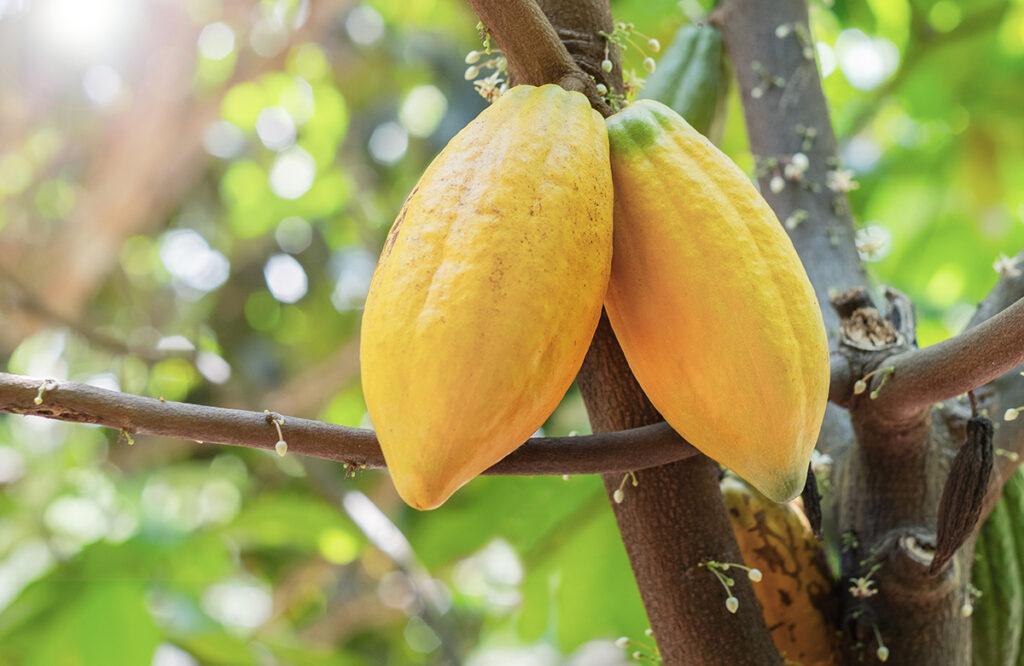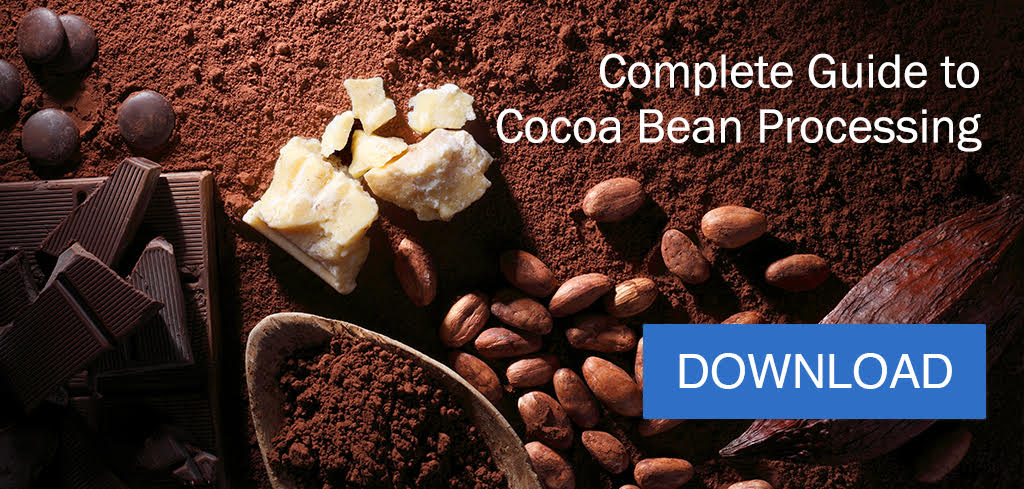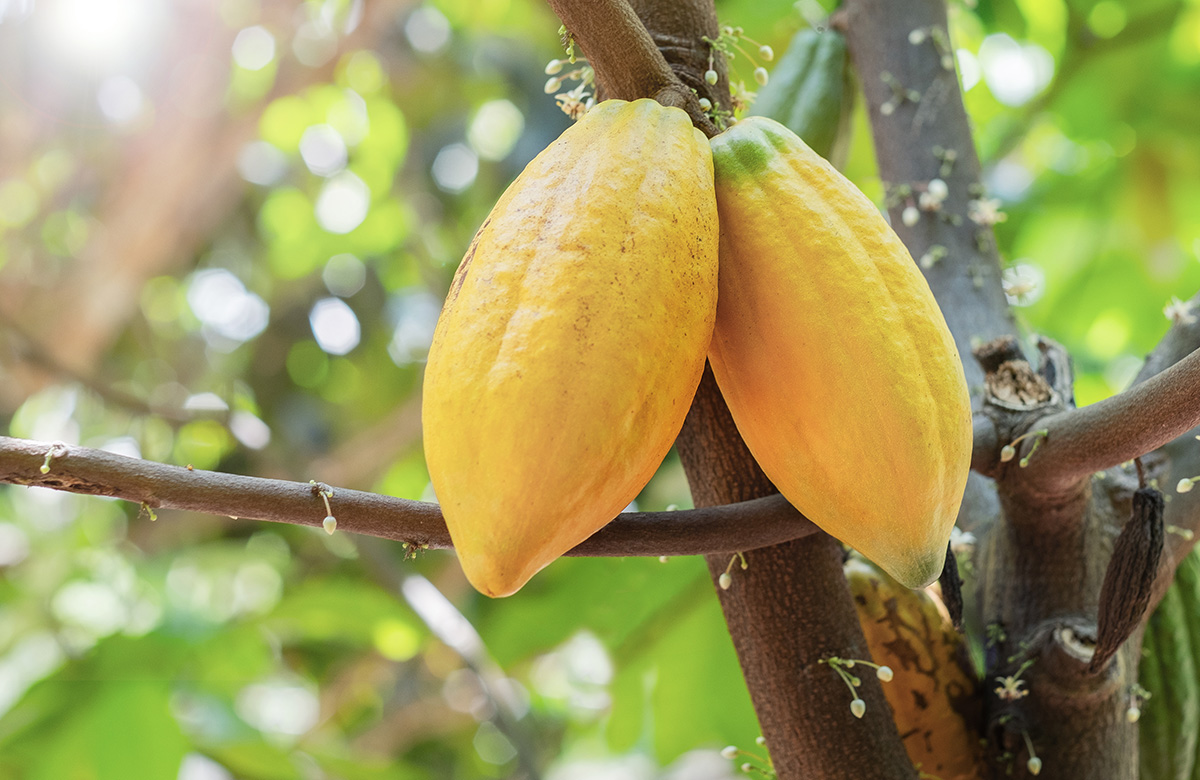
It’s no wonder why the source of cocoa beans, the cacao tree, was named “food of the gods” (Theobroma). The distinctively chocolatey flavor of cocoa products has been a favorite of countless civilizations throughout time—satisfying cravings both bitter and sweet, while supplying a bounty of beneficial qualities beyond food. However, many overlook the complexities of cocoa bean processing to turn a tropical cacao seed into a tasty chocolate bar.
Cocoa’s rich history dates back more than 5,000 years to the Amazon forests and Andes foothills where ancient populations of Maya, Inca, and Aztec tribes used indigenous cacao seeds as currency and as an ingredient to make a bitter drink used in rituals. After Spanish conquistadors carried the seed back to Europe, then throughout Latin America and Africa, cocoa quickly gained popularity as a drink fit for kings—and later, a key ingredient in chocolate.
Today, approximately 5 million metric tons of cocoa is produced around the Equator every year, with West Africa producing 70% of the world’s supply. Currently valued at $14.5 billion, the global cocoa market is expected to surpass $19 billion in the next five years. The world just can’t get enough chocolate.
Cocoa bean byproducts like cocoa butter, cocoa powder, and cocoa paste are essential components of chocolate and other food products. In addition, cocoa’s characteristic flavor, aroma, potential health benefits, and other unique physical properties make it valuable across applications, from cooking to cosmetics to pharmaceuticals and more.
To keep up with this growing demand for cocoa products, processors must be equipped to handle this tricky seed efficiently and manage the complex challenges of cocoa bean processing.

Pre-processing cacao
Millions of tropical smallholder farms cultivate cacao, often dual cropping the small trees under the shade of larger palms or banana trees. Seed pods grow out of the tree trunks, rather than branches, containing between 30 to 50 “cocoa beans” immersed in a sweet white pulp inside the leathery rind. Plantation workers chop mature, football-sized pods from the trees using sharp machetes, then split the pods open with wooden mallets.
Wet cacao seeds, still covered in pulp, are piled in heaps, covered with banana leaves, and left to ferment at the edge of the plantation for several days. This process converts sugars in the pulp into ethanol, breaking down the seed proteins as the pulp liquefies and drains away from the beans. The chemical reactions during fermentation start to develop the rich chocolatey flavor, color, and aroma associated with cocoa.
After fermentation, cacao seeds are dried in the sun or artificial dryers to reduce the moisture level from 60% to 7.5%. Drying the material too quickly can interrupt the fermentation process, leaving beans bitter, while drying too slowly can encourage the development of molds and off-flavors. Even before the beans leave the farm, the details of cocoa bean processing start to impact future product quality. It takes approximately 400 cocoa beans to make one pound of chocolate, although these raw beans don’t look or taste like chocolate yet. Fermented, dried seeds are bagged and shipped to cocoa bean processing plants, where the material will be transformed into cocoa paste, then separated into cocoa butter and cocoa powder.
Cocoa bean processing
Cocoa bean processing steps and methods vary depending on each manufacturer’s product specifications. Whole raw cocoa beans can be fed directly into the press, roasted whole and then shelled, or shelled and then roasted using just the nib. These process variations determine the quality of the resulting products.
Generally, cocoa bean processing includes these steps, in one order or another:
- Roasting whole beans or nibs to develop the classic chocolate flavor and aroma while reducing the moisture content to 5% for efficient pressing.
- Cracking and winnowing the whole bean to separate the shell from the inner kernel, or nib.
- Grinding nibs to melt the fat, or cocoa butter, from the solids, resulting in a cocoa paste or mass, sometimes called cocoa liquor.
- Alkalizing the liquor or nibs either before or after roasting to reduce bitterness. This optional alkali treatment is also referred to as the Dutch process, named for its country of origin.
Regardless of which order processors follow, cocoa bean processing culminates with pressing. Cocoa material — whether whole beans, nibs, or paste — is fed into a continuous screw press like the Anderson Oil Expeller® where mechanical force squeezes the oil, or cocoa butter, out of the cocoa solids, which exit the press as a cake.
Processors typically press this material twice to release as much cocoa butter as possible. The unique dual-press design of the Anderson Super Duo™ Series Expeller® efficiently crushes the material twice in a single pass, leaving residual oil levels as low as 10%.
Also read: Capitalizing on Specialty Oils and Fats with the Anderson Super Duo
Cocoa butter
Liquefied cocoa butter is filtered and cooled to create a valuable plant-based fat that’s solid at room temperature and melts around body temperature – which explains why chocolate melts in your mouth, not in your hand, according to one famous slogan.
Cocoa butter is blended with cocoa liquor, sugar, and other ingredients like vanilla and emulsifiers to make chocolate. The proportion of cocoa liquor to sugar determines the type of chocolate produced, like bittersweet varieties that contain at least 35% cocoa liquor by weight or milk chocolate varieties with only 10-15% cocoa liquor and the addition of whole milk solids for sweetness. White chocolate doesn’t contain any cocoa liquor at all.
Cocoa butter is most popular as an ingredient in chocolate making, but it’s also widely used in pharmaceuticals, cosmetics, and personal care products like lip balms and lotions, thanks to its velvety texture and emollient properties.
Cocoa powder
The solid cocoa press cake can be broken down and sold as fertilizer, animal feed, a raw source of theobromine for soft drinks or pharmaceuticals, or pulverized to create cocoa powder. If whole beans were pressed with bits of shell remaining in the solids, the cake is destined for the industrial meal market since food-grade cocoa powder cannot contain any shells.
Cocoa powder, made from nibs or cocoa liquor, can be used as an ingredient in a variety of foods and confections, such as drinks, desserts, puddings, sauces, ice creams, and more.
Cocoa opportunities
Long considered a high-fat snack food splurge, chocolate and other cocoa derivatives are gaining superfood status—thanks to rich concentrations of phytochemicals like flavonoids, theobromine, and antioxidants that promote a range of potential health benefits. That means chocolate isn’t just an indulgent craving; it packs anti-inflammatory, mood-boosting, and blood pressure-lowering perks, as well.
Popular across continents, centuries, and civilizations, from tropical tribes to European kings to modern populations everywhere, chocolate has proven to be a favorite flavor for all times. With ongoing growth expected for the global cocoa market, cocoa demand is outpacing supply as producers and processors strain to satisfy the chocolate cravings of the world.
To keep up with this demand, cocoa bean processing plants must optimize their methods and equipment to produce the highest quality byproducts for various applications. Anderson International has decades of experience pressing this notoriously tricky oilseed, and can provide both the equipment and the expertise to help processors maximize their success in this market.
